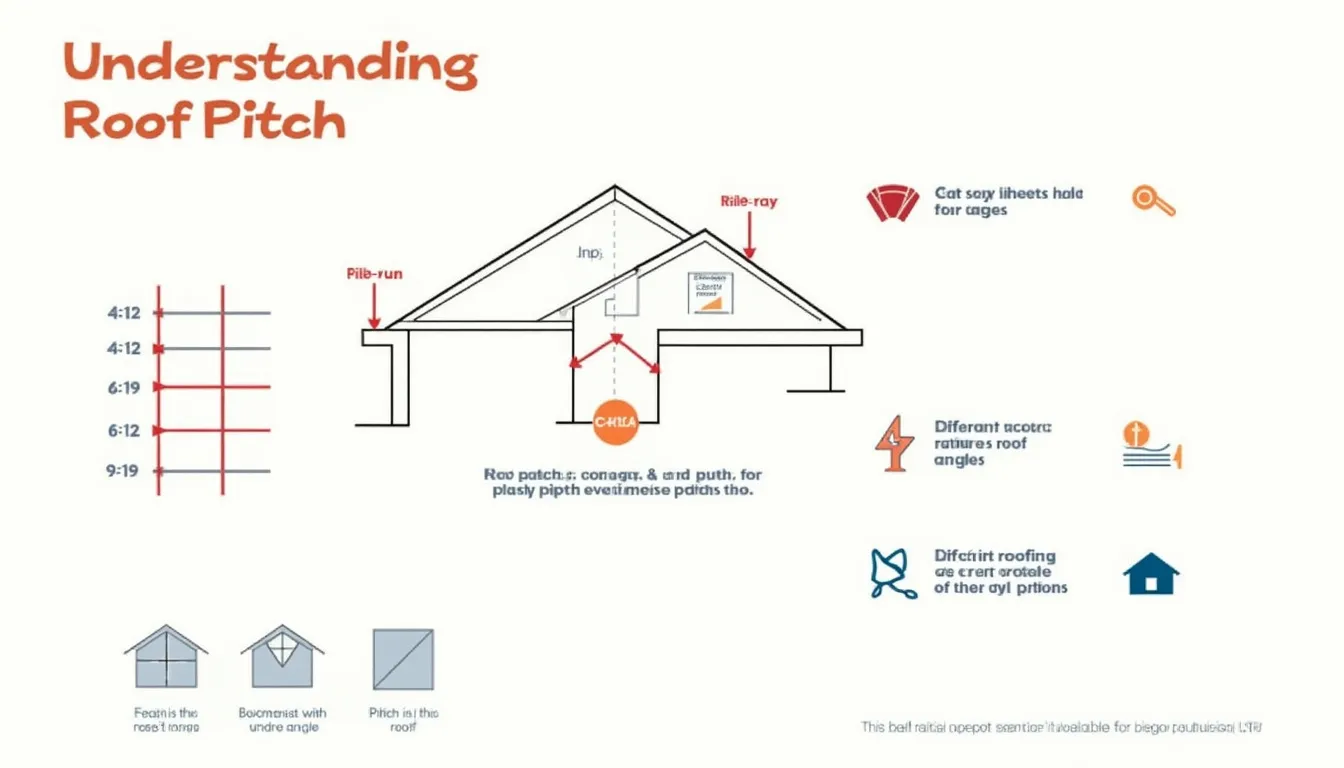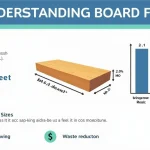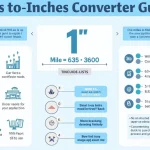Roof Pitch Calculator
Is this tool helpful?
How to Use the Roof Pitch Calculator Effectively
Our Roof Pitch Calculator is designed to help you determine various aspects of your roof’s slope quickly and accurately. Here’s a step-by-step guide on how to use this tool effectively:
- Enter the Rise (Optional): Input the vertical height of your roof in the “Rise” field. For example, if your roof rises 6 feet vertically, enter “6” in this field.
- Input the Run (Optional): Enter the horizontal distance over which the rise is measured in the “Run” field. For instance, if your roof extends 12 feet horizontally, input “12” here.
- Provide the Angle in Degrees (Optional): If you know the angle of your roof pitch in degrees, enter it in this field. For example, a common roof pitch angle might be “26.57” degrees.
- Specify the Pitch Ratio (Optional): If you’re familiar with the pitch ratio of your roof, enter it in the format “rise:run”. A common pitch ratio might be “6:12”.
- Select the Units: Choose the appropriate unit of measurement from the dropdown menu. Options include feet, inches, and meters.
- Click “Calculate”: Once you’ve entered at least two of the above values, click the “Calculate” button to generate your results.
The calculator will then display the results, including the calculated rise, run, angle, pitch ratio, and percentage slope. If you’ve provided insufficient information or there’s an error in your input, an error message will be displayed to guide you.
Understanding Roof Pitch: Definition, Purpose, and Benefits
Roof pitch, also known as roof slope, is a crucial aspect of building design and construction. It refers to the steepness or incline of a roof, typically expressed as a ratio of the vertical rise to the horizontal run. Understanding roof pitch is essential for various reasons, including proper water drainage, structural integrity, and aesthetic appeal.
Definition of Roof Pitch
Roof pitch is mathematically defined as the ratio of the roof’s vertical rise to its horizontal run, usually measured over a 12-unit horizontal distance. For example, a roof with a 6:12 pitch rises 6 units vertically for every 12 units of horizontal distance.
The mathematical formula for roof pitch can be expressed as:
$$\text{Roof Pitch} = \frac{\text{Rise}}{\text{Run}}$$Purpose of Roof Pitch
The primary purposes of roof pitch include:
- Water Drainage: A steeper pitch allows for faster and more efficient water runoff, reducing the risk of leaks and water damage.
- Snow Load Management: In snowy regions, a steeper pitch helps prevent snow accumulation on the roof.
- Attic Space: A higher pitch can create more usable attic space.
- Aesthetic Appeal: Different pitches can dramatically alter the appearance of a building, contributing to its architectural style.
- Energy Efficiency: The pitch can affect a building’s energy efficiency by influencing heat absorption and reflection.
Benefits of Understanding Roof Pitch
Knowing and accurately calculating roof pitch offers several benefits:
- Proper Material Selection: Different roofing materials are suitable for different pitches. Understanding your roof’s pitch ensures you choose the right materials.
- Accurate Cost Estimation: Roof pitch affects the amount of materials needed and the complexity of installation, influencing project costs.
- Compliance with Building Codes: Many areas have specific requirements for roof pitch, especially in regions prone to heavy snow or high winds.
- Improved Maintenance Planning: Understanding your roof’s pitch helps in planning maintenance tasks and assessing potential problem areas.
- Enhanced Design Decisions: For architects and designers, precise pitch calculations are crucial for creating harmonious and functional building designs.
Benefits of Using the Roof Pitch Calculator
Our Roof Pitch Calculator offers numerous advantages for homeowners, contractors, architects, and DIY enthusiasts. Here are some key benefits:
1. Time-Saving Calculations
Manual calculations of roof pitch can be time-consuming and prone to errors. Our calculator streamlines this process, providing instant and accurate results. This efficiency is particularly valuable for professionals who need to make quick assessments on multiple projects.
2. Versatility in Input Options
The calculator accepts various input combinations, allowing users to work with the information they have available. Whether you know the rise and run, the angle in degrees, or the pitch ratio, our tool can accommodate your needs.
3. Comprehensive Results
Beyond just calculating the pitch, our tool provides a range of related measurements, including:
- Roof angle in degrees
- Pitch ratio
- Percentage slope
- Rise and run calculations (if not provided)
This comprehensive output gives users a complete picture of their roof’s characteristics.
4. Improved Project Planning
Accurate pitch calculations are crucial for proper project planning. Our calculator helps in:
- Estimating material quantities
- Determining suitable roofing materials
- Planning for proper drainage systems
- Assessing the feasibility of solar panel installations
5. Enhanced Safety Measures
Understanding the exact pitch of a roof is essential for safety, especially when planning maintenance or renovation work. Our calculator helps users assess the steepness of a roof, allowing them to take appropriate safety precautions.
6. Cost Estimation Accuracy
By providing precise pitch measurements, our calculator aids in more accurate cost estimations for roofing projects. This can help avoid budget overruns and ensure proper resource allocation.
7. Educational Tool
For students, apprentices, or anyone interested in construction and architecture, our calculator serves as an educational tool. It helps users understand the relationships between different aspects of roof geometry.
Addressing User Needs and Solving Specific Problems
Our Roof Pitch Calculator is designed to address various user needs and solve specific problems related to roof design, construction, and maintenance. Let’s explore how this tool can be applied in different scenarios:
Scenario 1: Determining Suitable Roofing Materials
Problem: A homeowner is planning to replace their roof but is unsure which roofing materials are suitable for their roof’s pitch.
Solution: By using our calculator to determine the exact roof pitch, the homeowner can make an informed decision about roofing materials. For example:
- Input: Rise = 4 feet, Run = 12 feet
- Calculator Output:
- Pitch Ratio: 4:12
- Angle: 18.43 degrees
- Percentage Slope: 33.33%
With this information, the homeowner learns that their roof has a 4:12 pitch, which is suitable for various materials including asphalt shingles, metal roofing, and some types of tile.
Scenario 2: Planning for Solar Panel Installation
Problem: A contractor needs to determine if a roof is suitable for solar panel installation and calculate the optimal angle for the panels.
Solution: Using our calculator, the contractor can accurately determine the roof pitch and plan accordingly:
- Input: Pitch Ratio = 6:12
- Calculator Output:
- Angle: 26.57 degrees
- Percentage Slope: 50%
Knowing that the roof has a 26.57-degree angle, the contractor can determine that it’s within the ideal range (15-40 degrees) for solar panel installation in many regions. They can also use this information to calculate any necessary adjustments to optimize the panels’ angle.
Scenario 3: Estimating Materials for a New Roof
Problem: An architect needs to calculate the surface area of a roof to estimate material quantities for a new construction project.
Solution: Our calculator helps determine the roof pitch, which is crucial for accurate surface area calculations:
- Input: Rise = 5 meters, Run = 8 meters
- Calculator Output:
- Pitch Ratio: 5:8
- Angle: 32.00 degrees
- Percentage Slope: 62.5%
With this information, the architect can calculate the roof’s surface area using the formula:
$$\text{Surface Area} = \frac{\text{Run}}{\cos(\text{Angle})} \times \text{Width of the Roof}$$This allows for precise material quantity estimations, reducing waste and ensuring adequate coverage.
Practical Applications and Use Cases
The Roof Pitch Calculator has a wide range of practical applications across various fields. Let’s explore some specific use cases to illustrate its versatility and importance:
1. Residential Construction
In residential construction, accurate roof pitch calculations are crucial for various aspects of home building and renovation:
- New Home Construction: Architects and builders use roof pitch calculations to design homes that are both aesthetically pleasing and functionally efficient. For example, in a region with heavy snowfall, a steeper pitch might be preferred:
Example Calculation:
- Desired Pitch Ratio: 9:12
- Calculator Output:
- Angle: 36.87 degrees
- Percentage Slope: 75%
This steep pitch ensures efficient snow shedding, reducing the risk of roof collapse.
- Roof Replacement: When replacing an existing roof, contractors need to know the exact pitch to select appropriate materials and estimate costs accurately.
- Attic Conversions: Homeowners looking to convert their attic into living space can use the calculator to determine if their roof pitch allows for adequate headroom.
2. Commercial Building Design
Commercial buildings often have more complex roof designs, making accurate pitch calculations essential:
- Flat Roof Design: Even “flat” roofs typically have a slight pitch for drainage. Our calculator can help determine this minimal slope:
Example Calculation:
- Input: Rise = 0.25 feet, Run = 12 feet
- Calculator Output:
- Pitch Ratio: 0.25:12
- Angle: 1.19 degrees
- Percentage Slope: 2.08%
This slight slope ensures proper water drainage without compromising the flat roof aesthetic.
- Energy-Efficient Designs: Architects can use the calculator to optimize roof pitch for energy efficiency, considering factors like solar panel placement and natural lighting through skylights.
3. Roofing Industry
Roofing professionals rely heavily on accurate pitch calculations for various tasks:
- Material Selection: Different roofing materials have minimum pitch requirements. For instance, standard asphalt shingles typically require a minimum 4:12 pitch.
- Safety Planning: Roofers use pitch information to plan safety measures. Steeper pitches require more extensive safety equipment and precautions.
- Estimating Labor Costs: Roof pitch affects the complexity and time required for installation, directly impacting labor costs.
4. Solar Industry
The solar industry benefits significantly from accurate roof pitch calculations:
- Solar Panel Efficiency: The optimal angle for solar panels often correlates with the roof pitch. Solar installers use our calculator to determine if additional mounting adjustments are needed.
Example Calculation:
- Input: Angle = 30 degrees
- Calculator Output:
- Pitch Ratio: 6.93:12
- Percentage Slope: 57.74%
This information helps installers determine if the roof’s natural pitch is suitable for optimal solar panel performance or if adjustments are needed.
5. Insurance Industry
Insurance companies use roof pitch information for risk assessment and policy underwriting:
- Risk Assessment: Steeper roofs may be less prone to water damage but more susceptible to wind damage. Our calculator helps insurers accurately assess these risks.
- Premium Calculations: Roof pitch can influence insurance premiums, as it affects the likelihood and potential severity of damage.
6. Real Estate
In real estate, roof pitch information can be valuable for both buyers and sellers:
- Property Valuation: The roof’s pitch can affect a home’s overall value, particularly in regions where certain pitches are preferred for weather-related reasons.
- Future Planning: Potential buyers can use pitch information to assess the feasibility of future renovations or additions, such as installing skylights or solar panels.
Frequently Asked Questions (FAQ)
1. What is the most common roof pitch for residential homes?
The most common roof pitch for residential homes in many regions is 6:12, which means the roof rises 6 inches for every 12 inches of horizontal run. This pitch provides a good balance between aesthetics, functionality, and ease of construction. However, the ideal pitch can vary depending on local climate, architectural style, and building codes.
2. Can I use this calculator for both residential and commercial roofs?
Yes, our Roof Pitch Calculator is versatile and can be used for both residential and commercial roofs. It’s designed to handle a wide range of pitches, from nearly flat commercial roofs to steep residential pitches.
3. How does roof pitch affect the choice of roofing materials?
Roof pitch significantly influences the choice of roofing materials. For example:
- Low-slope roofs (2:12 to 4:12) typically require materials like built-up roofing or single-ply membranes.
- Moderate slopes (4:12 to 9:12) can accommodate a wide range of materials, including asphalt shingles, metal roofing, and tiles.
- Steep slopes (9:12 and above) may require specialized materials and installation techniques to prevent slippage.
4. Is there a minimum roof pitch for proper drainage?
Yes, for adequate water drainage, a roof should have a minimum pitch of 1/4 inch rise per foot of run (1:48 or about 2% slope). However, in areas with heavy rainfall or snowfall, a steeper pitch is often recommended for more efficient water and snow shedding.
5. How does roof pitch affect energy efficiency?
Roof pitch can impact a building’s energy efficiency in several ways:
- Steeper pitches in cold climates can help shed snow more efficiently, reducing the insulating effect of snow accumulation.
- In hot climates, a higher pitch can create more attic space, allowing for better ventilation and reducing heat buildup.
- The pitch also affects the angle at which sunlight hits the roof, influencing heat absorption and reflection.
6. Can I use this calculator to determine if my roof is suitable for solar panels?
Yes, our calculator can help you determine if your roof pitch is suitable for solar panels. Generally, a roof pitch between 15 and 40 degrees (about 3:12 to 10:12) is considered ideal for solar panel installation in most regions. However, the optimal angle can vary based on your specific location and local solar conditions.
7. How does roof pitch affect the cost of roofing projects?
Roof pitch can significantly impact roofing costs in several ways:
- Steeper roofs require more safety equipment and are more challenging to work on, potentially increasing labor costs.
- Higher pitches often require more materials due to the increased surface area.
- Some materials are more expensive for steeper pitches due to the need for additional fasteners or specialized installation techniques.
8. Can this calculator help me determine the load-bearing capacity of my roof?
While our calculator provides valuable information about roof pitch, it doesn’t directly calculate load-bearing capacity. However, knowing the pitch is a crucial first step in assessing load-bearing capacity, as it affects how weight is distributed across the roof structure. For a complete load-bearing analysis, consult with a structural engineer who can consider pitch along with other factors like roofing materials, truss design, and local building codes.
9. How often should I check or recalculate my roof pitch?
For most buildings, the roof pitch remains constant throughout the structure’s lifetime. However, it’s a good idea to verify or recalculate your roof pitch:
- Before any major roofing project or renovation
- If you notice any sagging or deformation in your roof structure
- When purchasing a new property
- If you’re planning to add solar panels or other rooftop installations
10. Can roof pitch be changed, and how would I use this calculator in that process?
Yes, roof pitch can be changed, although it’s a significant structural alteration. Our calculator can be useful in this process by:
- Helping you determine the current pitch as a starting point
- Allowing you to calculate the new measurements needed to achieve your desired pitch
- Assisting in estimating the change in roof surface area, which affects material quantities and costs
Remember, changing roof pitch is a major renovation that requires professional design and construction expertise to ensure structural integrity and compliance with local building codes.
Important Disclaimer
The calculations, results, and content provided by our tools are not guaranteed to be accurate, complete, or reliable. Users are responsible for verifying and interpreting the results. Our content and tools may contain errors, biases, or inconsistencies. We reserve the right to save inputs and outputs from our tools for the purposes of error debugging, bias identification, and performance improvement. External companies providing AI models used in our tools may also save and process data in accordance with their own policies. By using our tools, you consent to this data collection and processing. We reserve the right to limit the usage of our tools based on current usability factors. By using our tools, you acknowledge that you have read, understood, and agreed to this disclaimer. You accept the inherent risks and limitations associated with the use of our tools and services.







